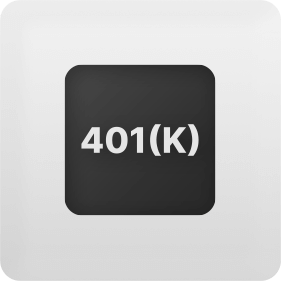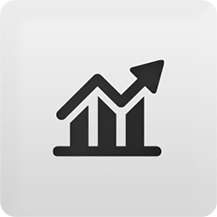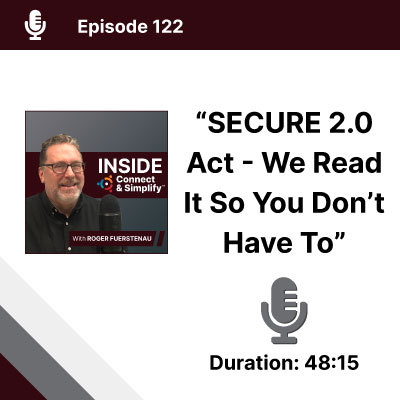SECURE Act 2.0 - What it Means For You
Upcoming Retirement Plan Changes for Small Businesses
SECURE Act 2.0 will give more small businesses and their employees the ability to improve retirement readiness and create a more secure future. Building on the reforms made by its predecessor, Act 2.0 may require you to amend your existing retirement plan offerings in order to remain compliant and avoid penalties. See a summary of the legislation's main clauses and how to use the new provisions to improve your business’s retirement plan offerings.





What is the SECURE Act 2.0?
SECURE Act 2.0 is an expansion of the original SECURE Act of 2019, now introducing new provisions on retirement savings and income strategy. The original SECURE Act, also known as The Setting Every Community Up for Retirement Enhancement (SECURE) Act, altered how money can be saved and withdrawn from retirement accounts.
Secure 2.0 Act was signed into law in late 2022, bringing over 90 changes to employee retirement savings plans. And its impact is already being felt. The amended act introduces new benefits for employers and employees, including new incentives for employers to offer retirement plans and to improve retirement outcomes through expanded participant coverage for employees. The act features changes impacting employees and small business owners immediately, and new provisions are scheduled to roll out in stages over time.
Key SECURE Act 2.0 Changes Small Business Employers Need to Know
Required Minimum Distributions
Increased age of required minimum distributions (RMDs) from 72 to 73 effective in 2023. The age requirement for RMDs will rise to 75 at the beginning of 2033. The excise tax penalty for missing RMDs has been decreased from 50% to 25%. Required minimum distributions were already not required for Roth IRA accounts, however, required minimum distribution rules did apply to Roth 401(k) accounts. Effective in 2024, there will no longer be a required minimum distribution for Roth 401(k)’s.
Incentivized Participation
Increased ability for employers to incentivize employees to contribute to retirement plans beyond just matching contributions. Effective in 2023, employers can now include modest incentives such as gift cards to promote participation.
Increased Catch-Up Contribution Limits Plus New Age Ranges to Track
Effective in 2023, catch-up contributions limits have been increased for 401(k), 403(b), and IRAs for workers aged 50 and older.
Effective in 2023, Optional Roth contribution preference where an employer can amend their workplace retirement plans to permit employees to elect employer matching and non-elective contributions made as Roth (after-tax) contributions. These contributions will be considered taxable income in the year of the contribution. (Retirement plan recordkeepers are still waiting for more guidance from the government on how to administer the feature.)
- The Catch-Up Contribution limit for employees who turn 50 in 2023 is raised from $6,500 to $7,500.
- Beginning after December 31, 2024 a new Catch-Up category has been created. Contribution limits will be raised for ages 60-63. It will be the greater of $10,000 or 50% over the indexed catch-up rate for people age 50 – 60. Contributions of 50% above the normal age 50 rate would be allowed. (indexed for inflation).
- New catch-up rules for those earning over $145,000
After 2023, all catch-up contributions for participants earning over $145,000 annually must be made on a Roth (after-tax) basis.
New Employee Automatic Enrollment
Reversed automatic enrollment in 401(k) plans to start in 2025, where automatic employee enrollment in workplace retirement plans becomes required of most major employers. The enrollment rate in these retirement plans will be required between 3% and 10% of eligible wages. Employees must be allowed to opt-out or withdraw automatic contributions within no more than 90 days of their first contribution. Certain plans are exempt from this rule. This change applies to most 401(k) plans, but there are some that are exempt from these new rules. This does not cover small companies with 10 or fewer employees, new companies in business for less than three years or church and government agencies.
Automatic Contribution Escalation
Automatic escalation, starting in 2025, where the contribution percentages of new employee retirement plans made after the conclusion of 2022 must increase by 1% every year after the completion of a year of service until the contribution is at least 10%.
Expanded Retirement Plan Eligibility for Part-Time Workers
Effective for 2025 and later plan years, SECURE 2.0 shortens the wait for long-term, part-time employees from three years to two, in addition to changing the rules in other ways. If an employee works 500 or more hours in two consecutive years, the plan administrator must allow the employee to make elective deferrals in the following plan year.
- ERISA-covered 403(b) plans are now included in this expanded coverage.
- SECURE 2.0 amends the Internal Revenue Code and adds the long-term, part-time provisions to ERISA, making this an enforceable right.
- Pre-2021 service is disregarded for 401(k) plan vesting purposes, effective as if included in SECURE 1.0.
Student Loan Repayment Assistance
Beginning in 2024, employers will have the option to match student loan payments as if they were payments to a qualified retirement plan. Under the new law, loan payments will be treated as elective deferrals just like your contributions, triggering SECURE Act 2.0 employer-matching contribution policies. This allows eligible employees of employers who choose to offer this match, to make saving for retirement a priority and not miss out on matching contributions for their retirement plans.
New Emergency Pull for 401(k)
The new SECURE 2.0 retirement law contains two main provisions related to emergency savings, both of which are optional for plan sponsors starting in 2024.
The first would permit the creation of a “sidecar” account tied to a participant’s retirement account. This account would be capped at $2,500, or a smaller amount set by the sponsor.
- Plans and traditional IRAs may permit one withdrawal per calendar year up to $1,000 for an unforeseeable or immediate financial need relating to necessary personal or family emergency expenses.
- This emergency personal expense distribution is exempted from the IRS 10% premature distribution penalty tax.
- The distribution may be repaid within 3 years and a subsequent distribution cannot be made until the repayment is completed.
- The plan administrator may rely on a certification by an employee seeking an emergency withdrawal unless the plan administrator has actual knowledge to the contrary.
New Employee Emergency Retirement Savings Accounts
Linked emergency savings accounts to retirement plans will start in 2024. Retirement plans will have the option to offer linked savings accounts, where non-highly compensated employees can make after-tax contributions to retirement savings account up to $2,500. Employees will have the option to make up to 4 withdrawals per plan year from the savings account penalty-free without the need to show a qualifying emergency cause.
Expanded Error Corrections
An expansion on the Employee Plans Compliance Resolution System (“EPCRS”) where more types of errors can be corrected internally. This also includes new rules for correcting overpayments and exempts certain failures to make required minimum distributions from excise tax.
Increased Employer Credits for Retirement Plan Administrative Costs
Employers now can receive a start-up tax credit of 100% percent on retirement plans for up to 50 employees. This is an increase from the previous numbers of 50% credit on less than 100 employees. Additional credits of up to $1,000 per employee may apply to employers with up to 50 employees.
Self-Certification of Hardship Requests
SECURE 2.0 also allows participants to self-attest that they meet IRS hardship criteria for the purposes of larger hardship withdrawals. Cimini explains that participants previously had to provide documentation of their hardship, such as an eviction notice, to claim a hardship withdrawal. Now they can simply self-attest.
Pros and Cons of SECURE Act 2.0 for Small Business Owners
How Small Business Owners Can Handle SECURE Act 2.0
SECURE Act 2.0 has pushed select changes into law immediately, with the full extent of changes scheduled to be rolled out in the coming years. As a small business owner, the new provisions may require you to amend your existing retirement plan offerings in order to remain compliant and avoid penalties. Making sense of current and future new changes in the regulations can be time-consuming and confusing. Will your current recordkeeper keep up with the changing retirement plans landscape? You need a plan provider who has this new info covered and can track who is eligible for what.
If your current benefits plan provider isn’t helping you keep up with new changes, The Benefit Companies through Connect & Simplify can help. Let our fully integrated business administration software and employee benefits plan specialists help you simplify the new incoming retirement plan rules. We’ll help you take advantage of the new incentives for offering employee retirement plans and can even benchmark your existing plans to help take the risk out of your hands as an employer. Contact us for a consultation today!

SECURE 2.0 Act – We Read It So You Don’t Have To
SECURE 2.0 Act – We Read It So You Don’t Have To
This podcast was recorded at Connect & Simplify™ HQ in Brookfield, Wisconsin. We help hundreds of state-wide small businesses understand complex retirement plan provisions in laws such as SECURE 2.0 Act. For many businesses in the 50-250 employee range, Connect & Simplify™ is a profitable or more effective alternative to full-time employees dedicating all or some of their time to managing the chaotic and complex problems of retirement plan provisions. Contact us for a FREE consultation.
Wisconsin Benefits Company Explains SECURE 2.0 Act
Listen as Roger Fuerstenau and Paul Dowd, CIMA®, AIF® discuss the SECURE 2.0 Act and the dozens of changes that it brings for 2023, 2024 and beyond. What is the goal of this act? What impact is there on your business and your retirement plan? Tune in and learn about the 400+ pages of how this act affects your retirement plan now and into the future. You don’t want to miss it!
We do all the things and are ready to help your business grow!
Secure 2.0 Act Podcast Outline:
- How to break down the new retirement plan provisions in an easy-to-understand format.
- Why the act affects businesses with and without existing retirement plans.
- How rules around minimum distributions are changing.
- How required distributions are now going to be waived for Roth 401(k)s.
- How employers now have options to incentivize employees to contribute to retirement plans.
- Why withdrawals from 401(k)s are now extended in the event of an emergency declared disaster.
- How catch-up contributions have changed.
- Why more guidance to the interpretations of SECURE 2.0 Act will have to wait for the future.
- What other retirement plan provisions are coming in 2024.
- Which provisions are down the road for 2025, including automatic enrollment for new 401(k) and 403(b) plans.
- How in 2033 the age for required minimum distributions goes up to 75.
- How Connect & Simplify is staying ahead of these new retirement plan changes.
- How small businesses can learn more about SECURE 2.0 Act from our team.
Frequently Asked Questions
The SECURE 2.0 Act of 2022 (SECURE 2.0) was included as part of the Consolidated Appropriations Act, 2023. The Act was signed into law as of December 30, 2022 by President Biden.
The SECURE 2.0 Act of 2022 (SECURE 2.0) was included as part of the Consolidated Appropriations Act, 2023. The Act was signed into law as of December 30, 2022 by President Biden.
SECURE 2.0 Act makes sweeping changes to 401(k) plans – particularly plans sponsored by small businesses. Included provisions in the plan include expanded participant coverage, actions to help participants preserve income, simplified plan rules and administrative procedures, as well as encouragement for employers and employees to adopt and join the plans.




